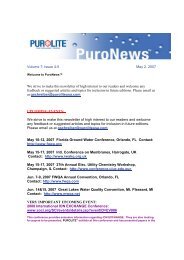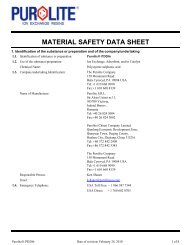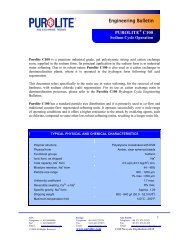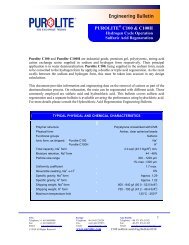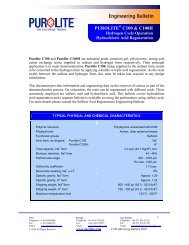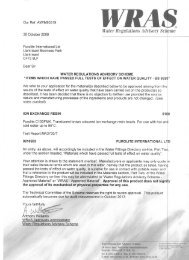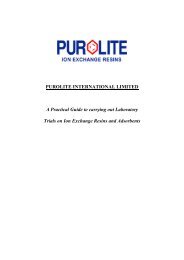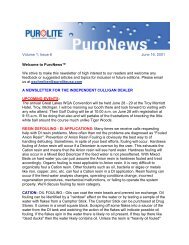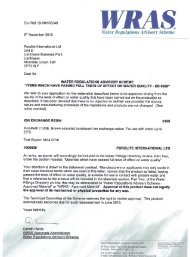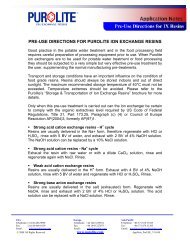Storage, Transportation and Preconditioning Brochure - Purolite.com
Storage, Transportation and Preconditioning Brochure - Purolite.com
Storage, Transportation and Preconditioning Brochure - Purolite.com
Create successful ePaper yourself
Turn your PDF publications into a flip-book with our unique Google optimized e-Paper software.
<strong>Purolite</strong> Product Bulletin .<br />
The <strong>Storage</strong>, <strong>Transportation</strong><br />
<strong>and</strong> <strong>Preconditioning</strong> of<br />
Ion Exchange Resins<br />
0<br />
© 2012 <strong>Purolite</strong> All Rights Reserved storage_bulletin_9July12<br />
<strong>Storage</strong> <strong>Transportation</strong> & <strong>Preconditioning</strong>
<strong>Purolite</strong> Product Bulletin <strong>Storage</strong>, <strong>Transportation</strong> & <strong>Preconditioning</strong><br />
General Guidelines<br />
<strong>Purolite</strong> Ion Exchange Resins are generally supplied in fully<br />
swollen moist bead form. Provided that transportation <strong>and</strong><br />
storage guidelines are followed, resins may be stored successfully<br />
for extended periods without significant deterioration. Some<br />
special products are supplied in a dry or partially-dried condition.<br />
In such instances, special care has to be taken as these resins<br />
may exp<strong>and</strong> considerably on re-hydration. Therefore, adequate<br />
space should be made available in the vessel to ac<strong>com</strong>modate<br />
the increase in volume.<br />
Ion exchange resins are supplied in specific ionic forms<br />
depending on application <strong>and</strong> may then be converted into a<br />
different ionic form by regeneration or in service duty.<br />
Depending on the conversion, resins can swell, remain<br />
unchanged or shrink in volume <strong>and</strong> designs of service units<br />
must ac<strong>com</strong>modate such changes. Some resins, such as acrylic<br />
strong base resins also undergo irreversible swelling in the first<br />
few operating cycles.<br />
Engineers <strong>and</strong> designers should refer to <strong>Purolite</strong> specific<br />
Product Data Sheet for information on irreversible <strong>and</strong><br />
reversible volume changes for different ionic forms.<br />
All ion exchange resins should undergo pretreatment prior to<br />
service, this is especially important for resins intended for food<br />
process or potable water treatment. Re<strong>com</strong>mended<br />
pretreatment for specific resin types <strong>and</strong> applications can be<br />
found on www.purolite.<strong>com</strong><br />
Shelf Life<br />
Table 1 provides the expected shelf life, in months, for various<br />
<strong>com</strong>mon ion exchange resins <strong>and</strong> applications. There are many<br />
factors that affect the shelf life of ion exchange resins, including<br />
storage conditions, preconditioning applied, <strong>and</strong> the intended<br />
application.<br />
To maximize shelf life of our products, it is essential that resin<br />
be protected from extremes of temperature <strong>and</strong> direct sunlight.<br />
Transport should be carried out using covered vehicles /<br />
containers <strong>and</strong> indoor temperature controlled warehousing<br />
utilized at site.<br />
<strong>Purolite</strong> products may be successfully introduced into service in<br />
many applications even after extended periods in storage.<br />
Table 1 provides engineers <strong>and</strong> end users a guide to the<br />
expected shelf life of <strong>Purolite</strong> resin families for a few <strong>com</strong>mon<br />
applications. These guidelines assume that products are<br />
transported, stored <strong>and</strong> introduced in the prescribed manner<br />
laid out in this document. Where end users are unsure about the<br />
exact transport <strong>and</strong> or storage conditions, or where over 50% of<br />
the expected shelf life has been reached, <strong>Purolite</strong> re<strong>com</strong>mends<br />
that extra precautions be taken when first using the ion<br />
© 2012 <strong>Purolite</strong> All Rights Reserved storage_bulletin_����12<br />
exchange resin, particularly for critical or regulated applications.<br />
Under these circumstances, we re<strong>com</strong>mend additional pretreatment<br />
before placing the resin in service. <strong>Purolite</strong> would be<br />
happy to provide advice on the use of products stored for<br />
extended periods. Further information, including your nearest<br />
<strong>Purolite</strong> office, can be found on www.purolite.<strong>com</strong>.<br />
<strong>Storage</strong> & <strong>Transportation</strong> Requirements<br />
1. Packaging<br />
Various types of primary packaging are employed with <strong>Purolite</strong><br />
resins. They are designed to ensure that the ion exchange<br />
resins are kept sealed to prevent either loss or uptake of<br />
moisture, as well prevent contamination.<br />
Contamination<br />
If packaging is damaged or left open <strong>and</strong> resins are exposed to<br />
the atmosphere, a risk exists that resins can deteriorate through<br />
a <strong>com</strong>bination of physical, chemical or biological contamination.<br />
Certain resins are supplied in special ionic forms. For example<br />
hydroxide form anion resins, when exposed to the atmosphere,<br />
can be<strong>com</strong>e carbonated from contact with carbon dioxide<br />
present in the air. Therefore, once the package is opened,<br />
resins should be used as soon as possible, <strong>and</strong> any unused<br />
resin adequately resealed in suitable clean containers.<br />
In the event of damage to bags, drums, kegs etc. every effort<br />
should be made to repair the damage to ensure the primary<br />
packaging remains sealed <strong>and</strong> not open to the atmosphere<br />
Dehydration<br />
Over time <strong>and</strong> especially at elevated temperatures, resins may<br />
dry out. Unless re-hydration is carried out carefully, beads will<br />
crack or break. To minimize damage use the following<br />
re<strong>com</strong>mended procedure for rewetting resins.<br />
A concentrated brine solution is slowly introduced <strong>and</strong> left for at<br />
least 1 hour to equilibrate. Brine displacement is carried out, by<br />
reducing brine concentration by 5% on consecutive treatments.<br />
A contact time of 30 minutes is used for each successive<br />
displacement. The final 5% brine solution is then displaced <strong>and</strong><br />
rinsed out with water. In cases where resin is very dry it is<br />
re<strong>com</strong>mended that the process is optimized in the laboratory by<br />
adjusting the starting concentration of brine, temperature, rates<br />
of addition <strong>and</strong> contact times.<br />
It should be noted that cation resins in the hydrogen form will<br />
generate hydrochloric acid by passage of brine through the bed.<br />
Anion resin in the hydroxide form will likewise produce sodium<br />
hydroxide (caustic soda). In each case cation resin will be<br />
converted to the sodium form <strong>and</strong> anion resin to the chloride<br />
form <strong>and</strong> will require multiple regenerations to return to the<br />
regenerated form.<br />
1
<strong>Purolite</strong> Product Bulletin <strong>Storage</strong>, <strong>Transportation</strong> & <strong>Preconditioning</strong><br />
2. Warehousing<br />
Exposure to high temperature <strong>and</strong> sunlight<br />
It is re<strong>com</strong>mended that <strong>Purolite</strong> resins are stored indoors. This<br />
is to maintain the temperature below 40°C, (104°F), <strong>and</strong> to<br />
ensure UV light (which can promote oxidation, <strong>and</strong> increase<br />
growth of algae <strong>and</strong> bacteria) does not fall upon the sealed<br />
packaging. It also follows that resin should not be stored near a<br />
radiator, or any other heating appliance, or in a warm boiler<br />
house.<br />
Exposure to low temperature <strong>and</strong> frost<br />
Although it has been shown that <strong>Purolite</strong> resins can withst<strong>and</strong><br />
temperatures as low as -40°C, (-40°F), successive thawing <strong>and</strong><br />
freezing may damage the product, <strong>and</strong>/or the packaging. Hence<br />
it is re<strong>com</strong>mended that the resins are stored above 0°C, (32°F).<br />
If for any reason a resin be<strong>com</strong>es frozen it should be left to thaw<br />
out naturally.<br />
Table 1. Expected Shelf Life of Ion Exchange Resins<br />
© 2012 <strong>Purolite</strong> All Rights Reserved storage_bulletin_����12<br />
No attempt should ever be made to free frozen resin<br />
mechanically.<br />
If it is anticipated that it will be necessary to h<strong>and</strong>le resin at subzero<br />
temperatures, the resin may be conditioned with saturated<br />
brine.<br />
Double stacking of full pallets in warehouses should be avoided.<br />
Where this cannot be avoided due to space requirements then<br />
pallet boards should be used between each pallet.<br />
3. <strong>Transportation</strong><br />
During transportation of resins, precautions should be taken to<br />
avoid the extremes of temperatures as outlined previously.<br />
If product be<strong>com</strong>es frozen during transportation, thawing should<br />
take place gradually, without any physical interference. Moving<br />
resin in their primary packaging should be avoided if possible<br />
when in a frozen state.<br />
Resin Family Shelf Life by Application,<br />
months from date of manufacture<br />
Type Ionic Form Potable<br />
Water &<br />
Food<br />
Industrial<br />
Water<br />
Treatment<br />
Nuclear<br />
Industry<br />
Ultra-pure<br />
Water<br />
Strong acid cation Na + 24 60 n/a n/a<br />
Strong acid cation H + n/a 36 24 6<br />
Strong acid cation NH4 + n/a 24 12 n/a<br />
Weak acid cation H + 12 60 n/a n/a<br />
Strong base anion Type 1 Cl - 24 60 n/a n/a<br />
Strong base anion Type 1 OH - n/a 24 24 6<br />
Strong base anion Type 2 Cl - 24 48 n/a n/a<br />
Strong base anion Type 2 OH - n/a 12 n/a n/a<br />
Strong base acrylic anion Cl - 24 48 n/a n/a<br />
Weak base anion<br />
Free<br />
Base<br />
24 60 n/a n/a<br />
Weak base acrylic anion<br />
Free<br />
Base<br />
24 48 n/a n/a<br />
Mixed Beds H + / OH - n/a ��������� 24 6<br />
Chelating Na + or H + 24 60 n/a 6<br />
2
Requirements for resin storage during<br />
equipment shut-down<br />
It is re<strong>com</strong>mended that some simple precautions are taken<br />
where ion-exchange equipment is to be shut down for an<br />
extended period.<br />
These will avoid the problems associated with the following:<br />
• dehydration<br />
• freezing<br />
• growth of bacteria, algae <strong>and</strong> moulds<br />
• chemical stability<br />
• precipitation <strong>and</strong> corrosion<br />
Dehydration<br />
For short term storage in the service vessels it is re<strong>com</strong>mended<br />
that the unit is filled with water. If draining is necessary, the<br />
vessel should be immediately sealed to prevent the resin from<br />
dehydrating.<br />
Freezing<br />
The vessel should be filled with dilute brine or ethylene glycol<br />
mixtures.<br />
Growth of bacteria, algae <strong>and</strong> moulds<br />
With long term storage in the service vessels where conditions<br />
are favorable, microorganisms such as algae <strong>and</strong> bacteria can<br />
proliferate in ion exchange plants. If such growth is allowed to<br />
continue unhindered, irreversible fouling of the resin <strong>and</strong><br />
blockage of the resin bed can occur.<br />
In order to ensure that the ion exchange plant remains in good<br />
working order, the following precautions should be taken prior to<br />
shut-down.<br />
All resin beds should first be subjected to an extended<br />
backwash, to remove any suspended material which may have<br />
collected during service, <strong>and</strong> regenerated to ensure the resin is<br />
in a “clean state” before conditioning for long term storage.<br />
Cation resins should then be exhausted with a 10% NaCl<br />
solution until neutral pH. All valves closed <strong>and</strong> resin beds left<br />
immersed in the sodium chloride solution for the period of shutdown.<br />
Anion resins might be advantageously treated with 2 to 3 bed<br />
volumes (BV) of alkaline brine (10% NaCl + 2% NaOH),<br />
allowing the last bed volume to st<strong>and</strong> for several hours before<br />
displacing with a further 2 BV of neutral brine (10% NaCl). The<br />
bed is then left immersed in the sodium chloride solution for the<br />
period of shut-down.<br />
© 2012 <strong>Purolite</strong> All Rights Reserved storage_bulletin_����12<br />
At the end of the shut-down, all resins are rinsed free of NaCl<br />
<strong>and</strong>, if necessary, sanitized with peracetic acid (See Sterilisation<br />
later).<br />
Where softeners are subject to regular shut-downs, or<br />
infrequent use, <strong>Purolite</strong> C100EAg, which has biostatic<br />
properties, should be considered to control biological fouling .<br />
Chemical Stability<br />
Strong <strong>and</strong> weak acid cation resins are quite stable in terms of<br />
ion exchange capacity. However, strong acid resins, after<br />
relatively short storage times, can produce some color throw.<br />
This is the result of trace leachables which diffuse from the resin<br />
matrix. This diffusion is more pronounced in hydrogen form<br />
strong acid cation resins. Therefore, in addition to classification<br />
backwash (where appropriate) the resin should be regenerated<br />
<strong>and</strong> rinsed prior to use. The sodium form resin is more stable<br />
but it is still prudent to carry out the above procedure before<br />
use.<br />
Where treated water is intended for human consumption or for<br />
use within the food industry, or when the resins are intended for<br />
direct food processing, preconditioning as specified by local,<br />
national or other regulatory authorities should be used (refer to<br />
the appropriate <strong>Purolite</strong> sales office for guidance).<br />
Strong base anion resins are quite stable in the chloride <strong>and</strong><br />
sulfate forms. The hydroxide form <strong>and</strong> to a lesser extent<br />
carbonate <strong>and</strong> bicarbonate forms slowly degrade even at room<br />
temperature to produce some weak base functionality at the<br />
expense of the strong base groups plus a small (almost<br />
insignificant) loss of total capacity. The degradation processes<br />
are accelerated at higher temperatures <strong>and</strong> the loss of total<br />
capacity be<strong>com</strong>es significant close to or above the maximum<br />
re<strong>com</strong>mended operating temperatures for the given resin type.<br />
It is therefore important to convert the resin to a salt form,<br />
generally chloride form, prior to shut-down or storage. This also<br />
avoids the generation of an amine odor which develops when<br />
hydroxide form anion resins are stored.<br />
Weak base anion resins are more stable <strong>and</strong> can be stored in<br />
both freebase or chloride form. To avoid possible bacteriological<br />
growth, the chloride form resin should be immersed in brine, as<br />
outlined above. This may be preferred for storage of used resin.<br />
Cautionary Note<br />
If cation or anion resins are left st<strong>and</strong>ing in the presence of<br />
strong oxidizing agents such as nitric acid there is a risk of<br />
explosion. This risk is greater at elevated temperatures. Before<br />
storage of resins in the nitrate form, it is re<strong>com</strong>mended that<br />
expert advice is sort. For full details on safe h<strong>and</strong>ling of ion<br />
3
<strong>Purolite</strong> Product Bulletin <strong>Storage</strong>, <strong>Transportation</strong> & <strong>Preconditioning</strong><br />
exchange resins or copolymers, please consult the relevant<br />
<strong>Purolite</strong> material safety data sheet (See web site<br />
www.purolite.<strong>com</strong>).<br />
Precipitation <strong>and</strong> Corrosion<br />
Care should always be taken to choose an ionic form of resin<br />
<strong>and</strong> water source for making up storage solutions which avoids<br />
the possibility of precipitation within the bed. For example a high<br />
hardness in the presence of high bicarbonate or hydroxide can<br />
cause precipitation which can block collector systems, foul the<br />
resin, <strong>and</strong> cause deposits which can set up corrosion. Such<br />
problems may occur when contaminant ions are oxidized or<br />
be<strong>com</strong>e insoluble as a result of any changes in temperature that<br />
may occur during shutdown.<br />
Care should also be taken to ensure that the storage solutions<br />
are <strong>com</strong>patible with materials of construction, not only the<br />
vessel / lining but also materials of construction for vessel<br />
internals. For example certain grades of stainless steel cannot<br />
ac<strong>com</strong>modate high chloride levels.<br />
<strong>Preconditioning</strong> re<strong>com</strong>mendations<br />
In this document we have advised on classification backwash<br />
(where appropriate) to ensure the bed is fully classified <strong>and</strong> that<br />
the lowest pressure drop across the bed is then encountered.<br />
We have also mentioned regeneration <strong>and</strong> additional rinsing to<br />
move trace leachables from new resin.<br />
We would also advise that when resins are first used, the ionic<br />
form required for the duty is often different to that the resin is<br />
supplied in. To convert the resin to the correct form a<br />
double/triple dosage of regenerant is employed. In most cases<br />
this will require an initial double / triple regeneration to<br />
substantially convert the resin to a high state of regeneration.<br />
Food Industry<br />
Special food grade resins are supplied to potable water <strong>and</strong><br />
food <strong>and</strong> beverage industries.<br />
Food grade resins undergo special production steps in their<br />
manufacture <strong>and</strong> additional post treatment to reduce any<br />
leachables that may be present <strong>and</strong> to meet specific regulatory<br />
<strong>and</strong> customer requirements.<br />
© 2012 <strong>Purolite</strong> All Rights Reserved storage_bulletin_����12<br />
However, on initial installation <strong>Purolite</strong> re<strong>com</strong>mends additional<br />
regenerations / rinsing, or in some cases special treatments to<br />
ensure the resin meets the required specifications <strong>and</strong> provides<br />
the best performance from day one. The end user should then<br />
test the water to ensure it satisfies his specific requirements for<br />
the application before placing the plant in service.<br />
In the unlikely event of any continued concerns about taste etc.<br />
further cycling between exhausted <strong>and</strong> regenerated forms will<br />
normally address the problem.<br />
Consult your local <strong>Purolite</strong> office if guidance is required.<br />
Sterilization<br />
In some industries there is an increasing dem<strong>and</strong> by the end<br />
users for regular <strong>and</strong> routine sterilisation of the water treatment<br />
system including the ion exchange plant. Sterilization is also<br />
required if biological contamination of a bed is suspected.<br />
Historically chemicals such as formaldehyde, sodium<br />
hypochlorite, hydrogen peroxide etc. have been used. The use<br />
of formaldehyde is no longer re<strong>com</strong>mended, as there are major<br />
concerns h<strong>and</strong>ling this material, <strong>and</strong> strong oxidizing agents can<br />
damage ion exchange resins. While hypochlorite <strong>and</strong> hydrogen<br />
peroxide solutions are still used, it is important to be very<br />
careful over the concentration <strong>and</strong> contact time employed as<br />
these chemicals can also damage the resin causing decrosslinking<br />
of the resin matrix <strong>and</strong> in the case of anion resins<br />
they will also chemically attack the resins’ active groups.<br />
The sterilization chemical of choice favored by many <strong>com</strong>panies<br />
is peracetic acid. A low hydrogen peroxide grade is widely<br />
available <strong>and</strong> this has been shown to work very effectively on<br />
cation <strong>and</strong> anion resins without seriously affecting the<br />
subsequent performance of the bed. A procedure for its use can<br />
be obtained from your local <strong>Purolite</strong> sales office.<br />
########<br />
<strong>Purolite</strong> Corporation was founded in 1981 <strong>and</strong> is a leading manufacturer <strong>and</strong> developer of ion exchange, catalyst, absorbent <strong>and</strong> specialty resins <strong>and</strong> is the<br />
only <strong>com</strong>pany to focus exclusively on this market. Headquartered in Bala Cynwyd, PA, the <strong>com</strong>pany has ISO 9000:2001 certified manufacturing <strong>and</strong> R&D<br />
facilities sites in North America, Europe <strong>and</strong> Asia, <strong>and</strong> sales offices in more than 30 countries. <strong>Purolite</strong>s’ dedicated “Centre of Excellence” research <strong>and</strong><br />
development facility is located in the United Kingdom <strong>and</strong> coordinates research in China, Romania, Russia, United Kingdom, <strong>and</strong> the United States of<br />
America.<br />
4
0<br />
Americas<br />
<strong>Purolite</strong><br />
150 Monument Road<br />
Bala Cynwyd, PA 19004<br />
USA<br />
Tel +1 610 668 9090<br />
Tel +1 800 343 1500<br />
Fax +1 610 668 8139<br />
Email info@puroliteusa.<strong>com</strong><br />
Europe<br />
<strong>Purolite</strong> International Ltd<br />
Llantrisant Business Park<br />
Llantrisant<br />
Wales<br />
CF72 8LF<br />
UK<br />
Tel +44 1443 229334<br />
Fax +44 1443 227073<br />
Email sales@purolite.<strong>com</strong><br />
Asia Pacific<br />
<strong>Purolite</strong> (China) Co. Ltd<br />
Room 707, C Section<br />
Huanglong Century Plaza<br />
No. 3 Hangda Road<br />
Hangzhou, Zhejiang<br />
China 310007<br />
Tel +86 571 876 31382<br />
Fax +86 571 876 31385<br />
Email info@purolitechina.<strong>com</strong><br />
For further information on <strong>Purolite</strong> products & services<br />
visit www.purolite.<strong>com</strong><br />
© 2012 <strong>Purolite</strong> All Rights Reserved storage_bulletin_9July12





